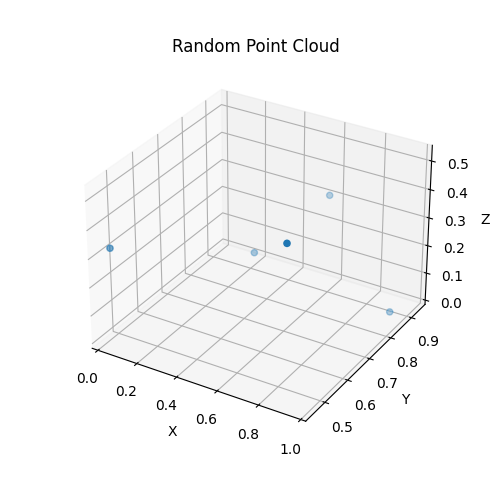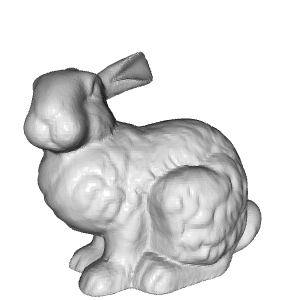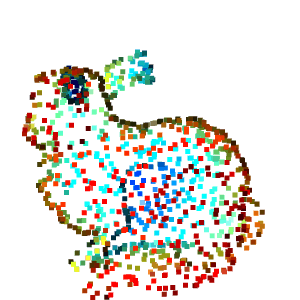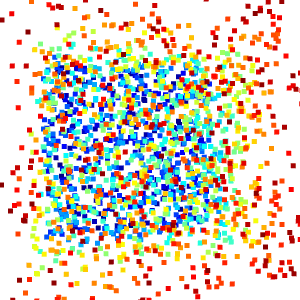Python: How to create and visualize point clouds
1. Introduction
Point cloud applications are everywhere: robots, self-driving cars, assistance systems, healthcare, etc. Point cloud is a 3D representation suitable for processing real-world data, especially when the geometry of the scene/object is required, such as the distance, shape and size of the object.
A point cloud is a set of points that represent a scene in the real world or an object in space. It is a discrete representation of geometric objects and scenes. In other words, a point cloud PCD is a collection of n points, where each point Pi is represented by its 3D coordinates:

Note that it is also Add some other features to describe the point cloud, such as RGB color, normals, etc. For example, RGB colors can be added to provide color information.
2. Point cloud generation
Point clouds are usually generated using 3D scanners (laser scanners, time-of-flight scanners and structured light scanners) or computer-aided design (CAD) models. In this tutorial, we will first create and visualize a random point cloud. We will then use the Open3D library to sample points from the 3D surface to generate it from the 3D model. Finally, we'll see how to create them from RGB-D data.
Let’s start by importing the Python library:
import numpy as np import matplotlib.pyplot as plt import open3d as o3d
2.1 Random Point Cloud
The easiest way is to randomly create a point cloud. Note that we generally do not create random points to process except when creating noise for a GAN (Generative Adversarial Network).
Usually, point clouds are represented by (n×3) arrays, where n is the number of points. Let's create a point cloud with 5 random points:
number_points = 5 pcd = np.random.rand(number_points, 3)# uniform distribution over [0, 1) print(pcd)
We could print the points directly, but it's not very efficient, especially in most applications if the number of points is large. A better approach is to display them in 3D space. Let’s visualize it using the Matplotlib library:
# Create Figure:
fig, ax = plt.subplots(subplot_kw={"projection": "3d"})
ax.scatter3D(pcd[:, 0], pcd[:, 1], pcd[:, 2])
# label the axes
ax.set_xlabel("X")
ax.set_ylabel("Y")
ax.set_zlabel("Z")
ax.set_title("Random Point Cloud")
# display:
plt.show()
Random Point Cloud Visualization
2.2 Sampling Point Cloud
Required for direct processing of 3D models time. Therefore, sampling point clouds from their three-dimensional surfaces is a potential solution. Let's start by importing the bunny model from the Open3D dataset:
bunny = o3d.data.BunnyMesh() mesh = o3d.io.read_triangle_mesh(bunny.path)
Or import it as follows:
mesh = o3d.io.read_triangle_mesh("data/bunny.ply")Next, display the 3D model to see how it looks. You can move your mouse to view from different viewpoints.
# Visualize: mesh.compute_vertex_normals() # compute normals for vertices or faces o3d.visualization.draw_geometries([mesh])

Rabbit 3D Model
To sample a point cloud, there are several methods. In this example, we uniformly sample 1000 points from the imported mesh and visualize them:
# Sample 1000 points: pcd = mesh.sample_points_uniformly(number_of_points=1000) # visualize: o3d.visualization.draw_geometries([pcd])

Rabbit Point Cloud
We can save the created point cloud in .ply format as follows:
# Save into ply file:
o3d.io.write_point_cloud("output/bunny_pcd.ply", pcd)2.3 Point cloud from RGB-D data
RGB-D data is generated using RGB -D sensor (such as Microsoft Kinect) collected, which provides both RGB images and depth images. RGB-D sensors are widely used in indoor navigation, obstacle avoidance and other fields. Since RGB images provide pixel colors, each pixel of the depth image represents its distance from the camera.
Open3D provides a set of functions for RGB-D image processing. To create a point cloud from RGB-D data using Open3D functions, simply import two images, create an RGB-D image object, and finally calculate the point cloud as follows:
# read the color and the depth image:
color_raw = o3d.io.read_image("../data/rgb.jpg")
depth_raw = o3d.io.read_image("../data/depth.png")
# create an rgbd image object:
rgbd_image = o3d.geometry.RGBDImage.create_from_color_and_depth(
color_raw, depth_raw, convert_rgb_to_intensity=False)
# use the rgbd image to create point cloud:
pcd = o3d.geometry.PointCloud.create_from_rgbd_image(
rgbd_image,
o3d.camera.PinholeCameraIntrinsic(
o3d.camera.PinholeCameraIntrinsicParameters.PrimeSenseDefault))
# visualize:
o3d.visualization.draw_geometries([pcd])
Colored point clouds generated from RGB-D images
3, Open3D and NumPy
Sometimes you need to switch between Open3D and NumPy. For example, let's say we want to convert a NumPy point cloud to an Open3D.PointCloud object for visualization, and use Matplotlib to visualize a 3D model of a rabbit.
3.1 From NumPy to Open3D
In this example, we create 2000 random points using the NumPy.random.rand() function, which starts from the uniform distribution of [0,1] Create a random sample. We then create an Open3D.PointCloud object and set its Open3D.PointCloud.points feature to random points using the Open3D.utility.Vector3dVector() function.
# Create numpy pointcloud: number_points = 2000 pcd_np = np.random.rand(number_points, 3) # Convert to Open3D.PointCLoud: pcd_o3d = o3d.geometry.PointCloud()# create point cloud object pcd_o3d.points = o3d.utility.Vector3dVector(pcd_np)# set pcd_np as the point cloud points # Visualize: o3d.visualization.draw_geometries([pcd_o3d])

3.2 从 Open3D到NumPy
这里,我们首先使用Open3D.io.read_point_cloud()函数从.ply文件中读取点云,该函数返回一个Open3D.PointCloud对象。现在我们只需要使用NumPy.asarray()函数将表示点的Open3D.PointCloud.points特征转换为NumPy数组。最后,我们像上面那样显示获得的数组。
# Read the bunny point cloud file:
pcd_o3d = o3d.io.read_point_cloud("../data/bunny_pcd.ply")
# Convert the open3d object to numpy:
pcd_np = np.asarray(pcd_o3d.points)
# Display using matplotlib:
fig, ax = plt.subplots(subplot_kw={"projection": "3d"})
ax.scatter3D(pcd_np[:, 0], pcd_np[:, 2], pcd_np[:, 1])
# label the axes
ax.set_xlabel("X")
ax.set_ylabel("Y")
ax.set_zlabel("Z")
ax.set_title("Bunny Point Cloud")
# display:
plt.show()
使用 Matplotlib 显示的兔子点云
4、最后
在本教程中,我们学习了如何创建和可视化点云。在接下来的教程中,我们将学习如何处理它们。
The above is the detailed content of Python: How to create and visualize point clouds. For more information, please follow other related articles on the PHP Chinese website!

Hot AI Tools

Undresser.AI Undress
AI-powered app for creating realistic nude photos

AI Clothes Remover
Online AI tool for removing clothes from photos.

Undress AI Tool
Undress images for free

Clothoff.io
AI clothes remover

AI Hentai Generator
Generate AI Hentai for free.

Hot Article

Hot Tools

Notepad++7.3.1
Easy-to-use and free code editor

SublimeText3 Chinese version
Chinese version, very easy to use

Zend Studio 13.0.1
Powerful PHP integrated development environment

Dreamweaver CS6
Visual web development tools

SublimeText3 Mac version
God-level code editing software (SublimeText3)

Hot Topics
 1377
1377
 52
52
 Do mysql need to pay
Apr 08, 2025 pm 05:36 PM
Do mysql need to pay
Apr 08, 2025 pm 05:36 PM
MySQL has a free community version and a paid enterprise version. The community version can be used and modified for free, but the support is limited and is suitable for applications with low stability requirements and strong technical capabilities. The Enterprise Edition provides comprehensive commercial support for applications that require a stable, reliable, high-performance database and willing to pay for support. Factors considered when choosing a version include application criticality, budgeting, and technical skills. There is no perfect option, only the most suitable option, and you need to choose carefully according to the specific situation.
 HadiDB: A lightweight, horizontally scalable database in Python
Apr 08, 2025 pm 06:12 PM
HadiDB: A lightweight, horizontally scalable database in Python
Apr 08, 2025 pm 06:12 PM
HadiDB: A lightweight, high-level scalable Python database HadiDB (hadidb) is a lightweight database written in Python, with a high level of scalability. Install HadiDB using pip installation: pipinstallhadidb User Management Create user: createuser() method to create a new user. The authentication() method authenticates the user's identity. fromhadidb.operationimportuseruser_obj=user("admin","admin")user_obj.
 Navicat's method to view MongoDB database password
Apr 08, 2025 pm 09:39 PM
Navicat's method to view MongoDB database password
Apr 08, 2025 pm 09:39 PM
It is impossible to view MongoDB password directly through Navicat because it is stored as hash values. How to retrieve lost passwords: 1. Reset passwords; 2. Check configuration files (may contain hash values); 3. Check codes (may hardcode passwords).
 Can mysql workbench connect to mariadb
Apr 08, 2025 pm 02:33 PM
Can mysql workbench connect to mariadb
Apr 08, 2025 pm 02:33 PM
MySQL Workbench can connect to MariaDB, provided that the configuration is correct. First select "MariaDB" as the connector type. In the connection configuration, set HOST, PORT, USER, PASSWORD, and DATABASE correctly. When testing the connection, check that the MariaDB service is started, whether the username and password are correct, whether the port number is correct, whether the firewall allows connections, and whether the database exists. In advanced usage, use connection pooling technology to optimize performance. Common errors include insufficient permissions, network connection problems, etc. When debugging errors, carefully analyze error information and use debugging tools. Optimizing network configuration can improve performance
 Does mysql need the internet
Apr 08, 2025 pm 02:18 PM
Does mysql need the internet
Apr 08, 2025 pm 02:18 PM
MySQL can run without network connections for basic data storage and management. However, network connection is required for interaction with other systems, remote access, or using advanced features such as replication and clustering. Additionally, security measures (such as firewalls), performance optimization (choose the right network connection), and data backup are critical to connecting to the Internet.
 How to solve mysql cannot connect to local host
Apr 08, 2025 pm 02:24 PM
How to solve mysql cannot connect to local host
Apr 08, 2025 pm 02:24 PM
The MySQL connection may be due to the following reasons: MySQL service is not started, the firewall intercepts the connection, the port number is incorrect, the user name or password is incorrect, the listening address in my.cnf is improperly configured, etc. The troubleshooting steps include: 1. Check whether the MySQL service is running; 2. Adjust the firewall settings to allow MySQL to listen to port 3306; 3. Confirm that the port number is consistent with the actual port number; 4. Check whether the user name and password are correct; 5. Make sure the bind-address settings in my.cnf are correct.
 How to optimize MySQL performance for high-load applications?
Apr 08, 2025 pm 06:03 PM
How to optimize MySQL performance for high-load applications?
Apr 08, 2025 pm 06:03 PM
MySQL database performance optimization guide In resource-intensive applications, MySQL database plays a crucial role and is responsible for managing massive transactions. However, as the scale of application expands, database performance bottlenecks often become a constraint. This article will explore a series of effective MySQL performance optimization strategies to ensure that your application remains efficient and responsive under high loads. We will combine actual cases to explain in-depth key technologies such as indexing, query optimization, database design and caching. 1. Database architecture design and optimized database architecture is the cornerstone of MySQL performance optimization. Here are some core principles: Selecting the right data type and selecting the smallest data type that meets the needs can not only save storage space, but also improve data processing speed.
 How to use AWS Glue crawler with Amazon Athena
Apr 09, 2025 pm 03:09 PM
How to use AWS Glue crawler with Amazon Athena
Apr 09, 2025 pm 03:09 PM
As a data professional, you need to process large amounts of data from various sources. This can pose challenges to data management and analysis. Fortunately, two AWS services can help: AWS Glue and Amazon Athena.




